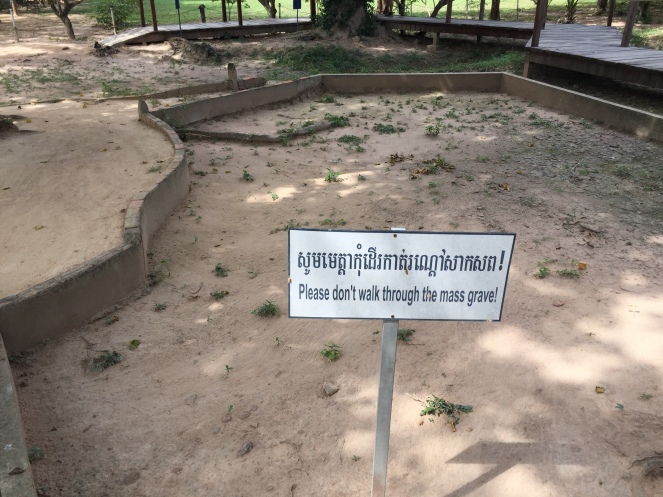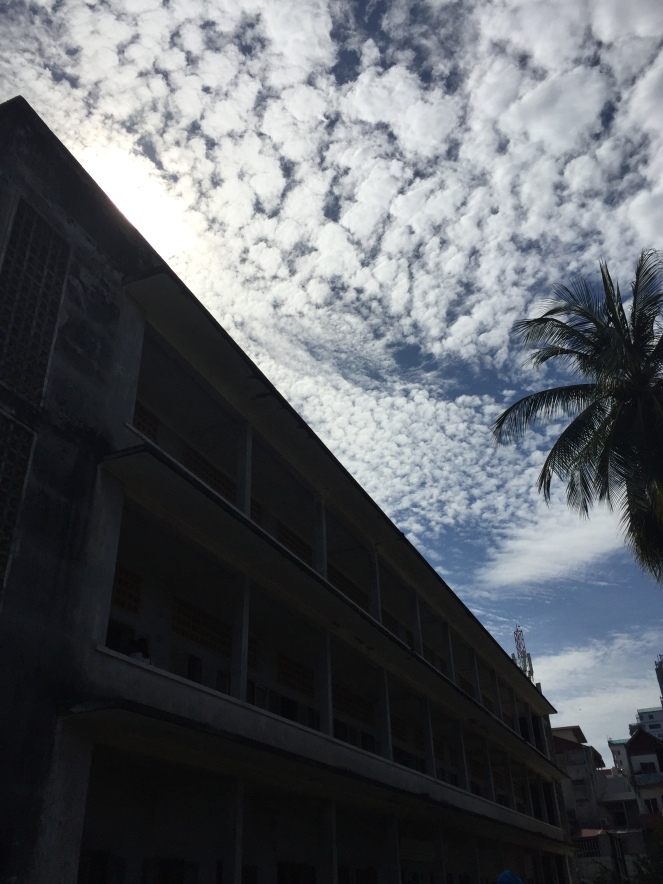We only really went to Phnom Penh for two places, and those places are horrible. But I’d be a terrible person if I didn’t talk about it, so…
SOME HISTORY: in 1975 a radical communist group, the Khmer Rouge, seized power of Cambodia’s government with a vision to turn Cambodia into a ‘communist agrarian utopia’, aka a nation full of rice farmers. Their methods included forcing everyone out of cities into the farmlands, whether they knew how to grow rice or not, and killing anyone who might disagree, like intellectuals and spies (they identified intellectuals by whether or not a person had glasses, soft hands or spoke a foreign language, and spies by whether or not they looked fishy). SPOILER ALERT: it failed. People can’t grow rice having eaten two spoonfuls of gruel in a day. Murdering a quarter of your population demoralises the troops. Communism is a fucking terrible way to run a country. By 1979 the regime had collapsed (it didn’t help that senior members kept offing one another in paranoia) and the Khmer Rouge were overthrown by rebels and the Vietnamese; what was left of the government fled to Thailand. Because Vietnam was involved, the United Nations actually continued to recognise the Khmer Rouge as Cambodia’s rightful government for years – they received aid and sent representatives to UN meetings. One day I will write about western countries ignoring genocide and send the manuscript to the Trump administration… Today is not that day but if you want to read more about the Khmer Rouge, go here. Anyway the Khmer people are very open about their past and are preserving and sharing it nationwide (unlike Nazi Germany, no one’s going to get away with denying this shit happened). The two biggest and most heartbreaking museums are both in or near Phnom Penh.
The Killing Fields of Choeung Ek
There are killing fields all over Cambodia, but the largest is at Choeung Ek, which used to be a Chinese graveyard and orchard a few miles from Phnom Pehn. We visited there first and just arriving was odd, because the road goes through what is now basically a suburb – it felt a bit like having a war memorial at a corner in central Southend. Once you’re in, though, Choeung Ek feels more like a nature reserve than a genocide spot. There’s an audio tour that takes you to various points, and they’ve let a lot of the space grow naturally back into an orchard. There’s even a pond, although if I remember correctly there are still a lot of bodies under it. Speaking of bodies…

Because the Khmer Rouge wanted to save bullets, they had people killed using what was lying about instead. Think farming equipment, knives, tyre irons and the like. As a result, the corpses uncovered since aren’t exactly intact; every now and then bits of bone and skull and clothes work their way up to the surface and museum staff take care of them. What they have found has been examined and organised neatly in a memorial stupa, which is simultaneously very beautiful and very creepy.

Tuol Sleng Genocide Museum
After lunch we headed to Tuol Sleng in central Phnom Penh, also known as Security Prison 21. For what it’s worth I found the museum harder to deal with than the Killing Fields, and I’d recommend doing Choeung Ek second. There’s more fresh air, less graphic photos and more space to sit by yourself while you try to process what you’ve just seen – the building was originally a school, so it’s quite compact and overbearing. There’s an audio tour for the museum as well so you can do it at your own pace, but I still wanted to inhale a bottle of gin by the time I was a third of the way around.
They request you don’t take photos of the inside rooms, which was fine by me. Just, imagine a tiled room that used to be a classroom, with a rusting iron bed in the middle. In its heyday, it would have been a nice bed. The iron is wrought into patterns. It was an interrogation room, so add rusting iron shackles and perhaps an iron bar. Finally, turn to one wall and add a large black and white photograph of that very room. Attached to the bed is what used to be a person. It’s an old photograph, taken straight after the prison was discovered, but you can still tell that that used to be someone’s head and that was someone’s stomach, and that is where their stomach ended up. Then multiply the room by four or five because when the regime fell, the prison staff knew they had very little time to flee. They stopped torturing that day’s suspects and killed them to avoid future identification – but they couldn’t risk gunshots being heard, so they hacked their prisoners to death then skedaddled.
That’s just the first part of the museum.

There are several rooms full of photographs of prisoners and several pieces of torture equipment, including one which was originally used as gymnastic equipment for the school. The Khmer Rouge were meticulous about records, but they destroyed a lot toward the end; what’s left is quite enough to put you off believing in any sort of benevolent deity. Most pictures are just of people when they arrive, but there’s a few of prisoners mid-captivity. There were only seven people found alive when the prison was liberated, and one was an artist who went on to paint what he saw, so there are also canvases of torture and general death in glorious technicolour. An estimated 20,000 people were held at S-21 during the regime. Seven were found alive.
We ended up rushing a little toward the end of the tour – well, I did. Maxim finished way quicker and was impatient to leave because we needed to get bus tickets for Shianoukville. Part of me was irritated for skipping the exit, because two of the surviving prisoners were there signing books, but part of me was very relieved to be given a reason to leave. I could easily go back and spend a day making notes, listening to every extra on the audio tour and piecing together everything that’s there (with a break for lunch and the gin) but I could also quite happily never set foot in Phnom Penh again. It’s not that the city – and Cambodia in general – isn’t vibrant and bustling and very ready to be more than just four years in its history. It’s that in my head, once I’d seen Choeung Ek and S-21, it was hard to see anything else. I kept thinking ‘that building’s definitely been built since the seventies’, ‘that building hasn’t’, ‘this guy looks old enough to have lived through the genocide’. Anecdotally, there are no old people in Cambodia; statistically, one in four people died under the Khmer Rouge either from malnutrition, disease or execution.
It feels very relevant that I’m writing this the day after Holocaust Memorial Day, and the day after the Trump administration signed an order banning Syrian refugees from entering the US. Incidentally one of the factors in the Khmer Rouge’s rise to power is that America dropped more bombs on Cambodia during the Vietnam War than it did during the entirety of World War II; the resulting poverty and civil unrest stoked support for the party. I could keep drawing parallels between Pol Pot’s Cambodia and Nazi Germany, and parallels between them and the rhetoric Trump and his supporters are spewing, but if you’re reading this you’re probably smart enough to draw them yourselves.
Phew! Francesca!……credit to you & Maxim for visiting both places……not sure I could. I Have read a few books & articles over the years on this & I just can’t get my head around human beings behaving like this…..
LikeLiked by 1 person
They’re definitely both worth visiting, you’ve just got to steel yourself, take your time and take some time afterwards to digest it (or digest it as best you can, anyway… it’s been two weeks and I’ve not really got used to the idea of what happened).
LikeLike
Wow…..so very interesting Francesca…..salient and yet also descriptive enough to get a very real sense of this disturbing part of history and the emotions it evokes.
LikeLiked by 1 person
Thanks! Who is this?
LikeLike